
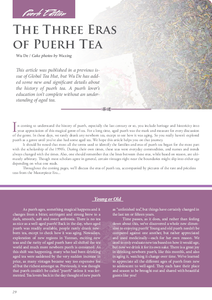 |
|

In coming to understand the history of puerh, especially the last century or so, you include heritage and historicity into your appreciation of this magical genre of tea. For a long time, aged puerh was the mark and measure for every discussion of the genre. In those days, we rarely drank any newborn tea, except to see how it was aging. So you really haven't explored puerh as a genre until you've also had some aged tea. We hope this article helps you on that journey.
It should be noted that most all the terms used to identify the families and eras of puerh tea began for the most part with the scholarship of the 1990's. During their own times, these teas were everyday commodities, and names and trends always changed with the times. Also, one should remember that the lines between these eras, while based on reason, are ultimately arbitrary. Though most scholars agree in general, certain vintages right near the boundaries might slip into either age depending on what one reads.
Throughout the coming pages, we'll discuss the eras of puerh tea, accompanied by pictures of the rare and priceless teas from the Masterpiece Era...
As puerh ages, something magical happens and it changes from a bitter, astringent and strong brew to a dark, smooth, soft and sweet ambrosia. There is no tea as nice as a well-aged puerh! Back in the day, when aged puerh was readily available, people rarely drank newborn tea, except to check how it was aging. Nowadays, exploration of new regions in Yunnan, exciting new teas and the rarity of aged puerh have all shifted the tea world and much more newborn puerh is consumed. As this shift was happening, many who had been drinking aged tea were saddened by the very sudden increase in price, as many vintages became way too expensive for all but the richest amongst us. Previously, it was thought that puerh couldn't be called "puerh" unless it was fermented. Tea lovers back in the day thought of new puerh as "unfinished tea", but things have certainly changed in the last ten or fifteen years.
Time passes, as it does, and rather than feeling down about this, we've discovered a whole new dimension to enjoying puerh! Young and old puerh needn't be compared against one another, but rather appreciated and used medicinally - each for her own reason. We used to only evaluate new tea based on how it would age, but now we drink it for its own sake. There is a great joy in drinking newborn puerh, like this month's, and also in aging it, watching it change over time. We've learned to appreciate all the different ages of puerh from new to adolescent to well-aged. They each have their place and season to be brought out and shared with beautiful guests like you!
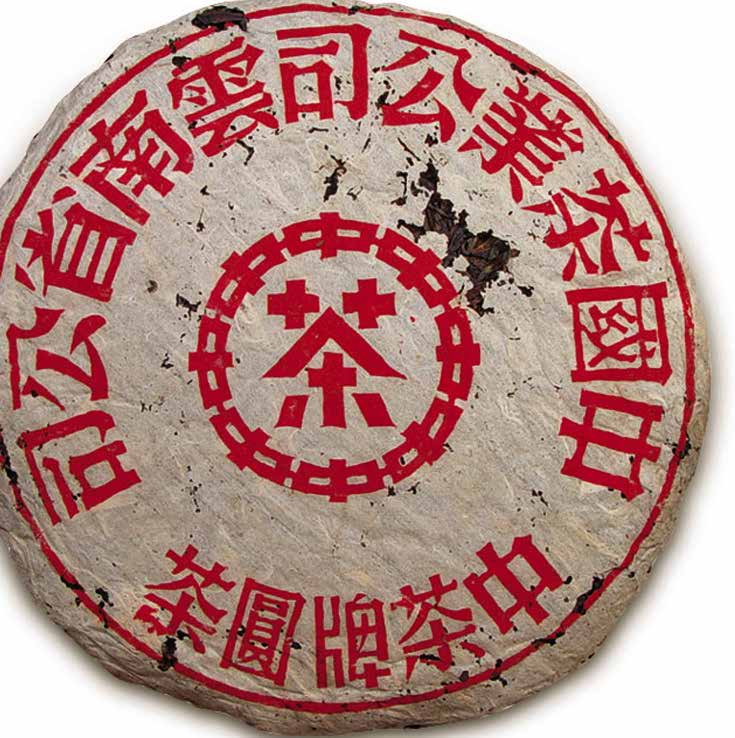

This era of tea includes all the tea that was produced prior to the formation of Communist China in 1949. All of the factories from that time were private businesses and none had anywhere near the output of those today. Many of these trading firms also dealt in other goods as well, like rice and other agricultural products. Puerh tea was just one commodity amongst others. Some of them were even owned by single families, like the legendary Song Ping Hao and Tong Qing Hao. They were often small, rural houses where tea and other products were all processed completely by hand. The demand of the market at that time was small and annual production in numbers that would make even the state-owned factories of later years scoff. Old tea house owners in Hong Kong have reported that 10 jian (or "cases", each with 84 cakes, therefore equaling 840 cakes) was enough for the entire island for one year. The demand for puerh was low because the retail price was relatively high compared to other teas. Nevertheless, many would argue that the cleaner and more natural farming methods and environment lent these cakes a certain majesty not found in any of their descendents. The fact that many of these teas are now 70 or more years old, coupled with the fact that very few were produced to begin with, makes them extremely rare and valuable - sometimes costing more than a hundred thousand USD per cake.
The cakes from the Antique Era were never wrapped with an outer wrapping paper. Perhaps it was considered too costly at the time; and preservation wasn't as much of an issue. However, all the cakes did have a nei fei or "inner trademark ticket" embedded into the tea just like the ones of today. Many also had a nei piao or "stack ticket" that rested in each stack of seven cakes (tong). Other than the leaves themselves, these trademarks are really the only way that collectors can tell cakes apart, especially ones from the same factory, like for example the Red and Blue Mark Song Ping Hao cakes. The leaves in these ancient cakes were larger-leaf blends, and were harvested completely from old-growth trees.
When the "New China" was established in 1949, the central government declared that all industry belonged to the people. Even the tea industry was handed over to the local government. These changes closed these family-run, private businesses in the 1950's and the Antique Era came to an end.
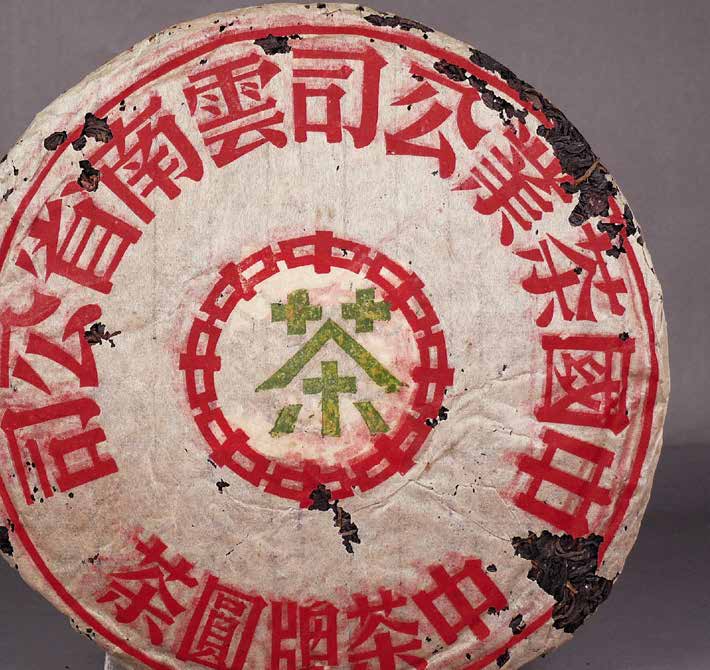
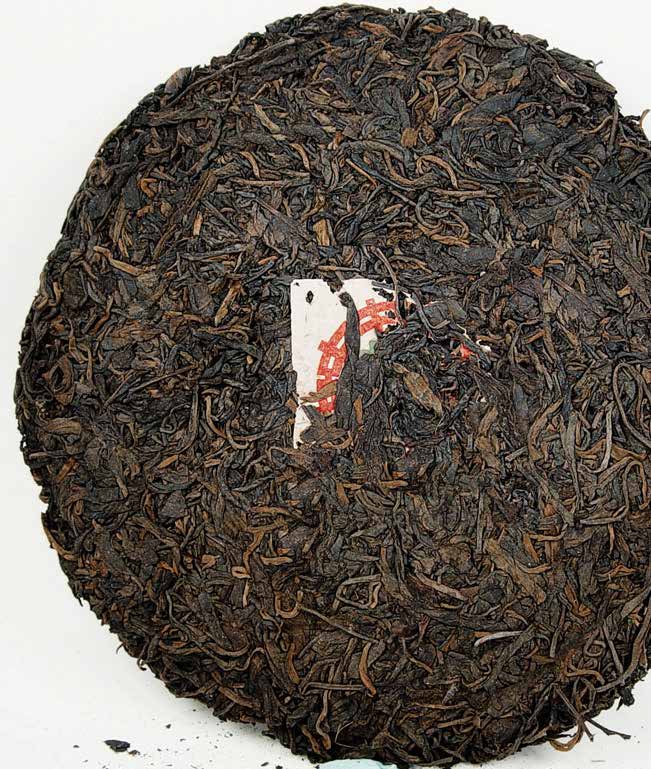
The start of the Masterpiece Era began with the creation of the state-run factories, like Menghai, which is still in existence today (though it is privately owned now). In order to control and stabilize the production of tea in Yunnan, the "China Tea Corporation, Yunnan Branch" was created. They had their own logo, brand and trademark - established in 1950, and registered with the central government in 1951. This trademark is the now famous "8-Zhong Tea" character that is in the center of all the cakes from the Masterpiece and later Seven Sons eras. The character "zhong (中)" means "middle" or "Middle Kingdom", viz. China. Eight of them surround the character for tea (茶) since that number was considered lucky. It also symbolized the goal of distributing Chinese tea to all eight directions of the world.
Red and Blue Mark teas, as well as others from the Masterpiece Era, are now also very rare. While they aren't as expensive or as difficult to find as Antique Age teas, many vintages are quickly approaching comparative values. Like the older teas, these too are treasures.
Tea cakes in the Masterpiece Era are distinguished from earlier ones by the obvious change to using outer wrapping paper. All these cakes were wrapped in handmade papers with the "8-Zhong" trademark in the center. The name of the "China Tea Corporation, Yunnan Province Branch Company" was printed in a ring around the central character, and read from right to left (which helps distinguish these cakes from later ones produced in the Seven Sons Era). The style and methods used to wrap seven cakes into tongs didn't change in the Masterpiece Era: they still used bamboo bark with soft bamboo twine to hold the tong closed.
The Masterpiece Era is considered to be the 1950's and 60's, and characterized by four main categories of tea. Some authors subdivide these cakes into more varieties. This list is, therefore, a gross simplification, as most Chinese anthologies will include some later teas in this era, as well as subdivide these categories into many cakes. Nevertheless, this is a start to understanding the Masterpiece Era:
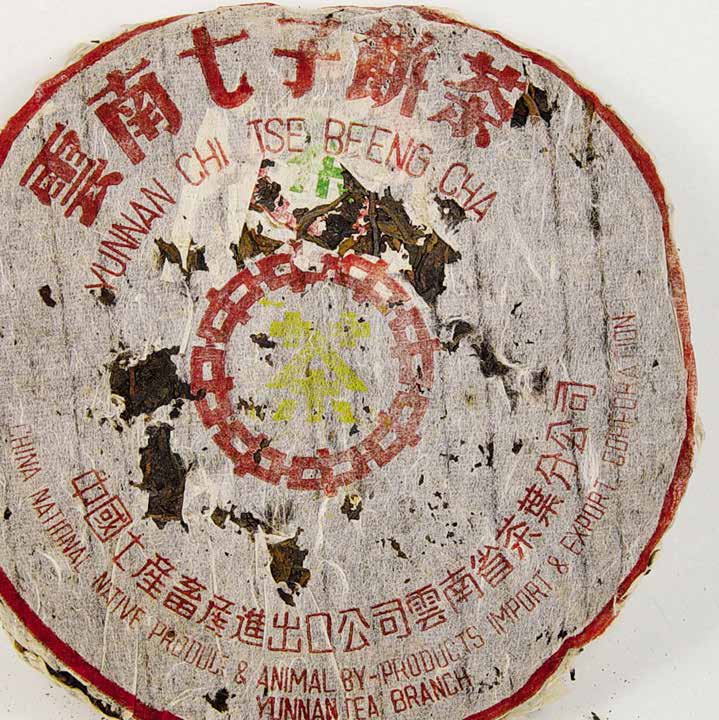

The Seven Sons Era began in 1972 with the formation of the now-famous "China National Native Produce & Animal By-product Import & Export Company", referred to so often as the "CNNP". The new agency would take control over all the puerh production during the period. The three main factories of the time period were Menghai, Xiaguan and Kunming. During this time, the production of puerh tea increased as a result of a growing foreign market. More tea was exported than ever before. As a result, more of these teas are floating around the vintage market than their predecessors, though some of these famous vintages are also now starting to become rarer and more expensive. Some of the earliest cakes from this era are just now starting to reach maturity, and connoisseurs are all interested in tasting these vintages as well as the earlier ones.

When the CNNP took over the production of puerh in Yunnan they changed several aspects of the design used to package tea, as well as the blends and raw materials. Consequently, besides the change in management, these changes justify the demarcation of two eras of tea at this time. Firstly, all the teas were no longer called "Yuan Cha" or "Round Tea Cakes"; instead, they were all now called "Qi Zi Bing Cha", which literally means "Seven Sons Tea Cake". As mentioned before, the characters on these cakes also changed from 'right to left' to 'left to right.' The cakes made by Menghai also began using Roman Pinyin font beneath the Chinese for the purpose of exportation. (Xiaguan and Kunming factories were slower in making this change). Menghai also began adding a nei piao between every cake and outer wrapping. Scholars often differentiate these nei piao tickets from the ones used in the Antique age by calling them "Description Tickets" and the earlier ones, "Stack Tickets". The nei piao from the Seven Sons Era were called "Description Tickets" because they contained short descriptions of the tea inside, sometimes with the region, product information or even marketing about the health benefits of puerh tea. Again, Xiaguan and Kunming's early Seven Sons Era cakes didn't have these nei piaos inside. Of course, the name around the "8-Zhong Tea" was also changed from the China Tea Corporation to the CNNP. There were several other changes in packaging at this time, like the use of metal wires to tie tongs, factory and batch codes and even changes to the design of the nei fei tickets compressed into the tea.

Many state-produced bingchas have a four-digit production number. This trend began in the late 1960's or early 1970's and consequently doesn't apply to very old antique puerh. These were internal factory batch codes originally and were only known and used by factory workers and merchants who ordered from them. Nowadays, however, the old recipes have become famous and many companies, small and large, are trying to reproduce the famous "7542" or our favorite, "8582". Consequently, it's worth knowing a little of what these codes are about.
Basically, the first two digits are the year in which that production was first started. If a particular mixture/ processing procedure marketed well, it was then continued the next year, sometimes even for decades to the present. In other words, if the first two digits are "75," this means that this particular production method/ mixture was first begun in 1975. This doesn't mean that the tea itself dates to 1975. It could be a 2006 cake. It just means that the recipe itself began in 1975. The methods used to blend and process puerh tea into cakes are often experimented with until better formulas are developed.
The third digit refers to the leaf size or "grade" used in production of the cake. Grades of teas were and are often very complicated. Different factories follow different guidelines and/or change them over time. Generally, though, the first grade leaves are the smaller ones, buds, and then the bigger the leaves and further back up the stem, the higher the grade. In the olden days, the first four grades were often used to process bowls or nest-shaped teas (tuochas 沱茶) and mushrooms (jingcha 緊茶) and larger fifth through ninth grades were reserved for bingcha and brick puerh. This has changed in the modern era. Nowadays all different kinds of cakes are made from the selection of grades.
The word "grade" can occasionally confuse English-speaking people. This is because the grade mentioned above is not always relevant to quality. Of course, a first grade leaf is more expensive by weight because the buds are smaller and there is a lot less of them. But price and quality are not always commensurate. The word "grade" in English also denotes "quality" and is therefore misleading. There are two Chinese words, one for the grade (dang ji 等級), i.e. size and location of the leaves on the plant, and another for the quality of the leaves/tea (pin tze 品質). Many times the first leaves are better quality, but not always.
The final number in the four-digit code refers to which state factory produced the cake. Knowing the factory can often help determine the tea-growing region in which the raw material was farmed as well. In those days there weren't so many factories as today. As we mentioned above, these recipes are now copied or commemorated by many different factories, so the last number has less relevance in modern times. The numbering for the factories is as follows:
| 1 | Kunming Tea Factory (昆明茶厂) | |
| 2 | Menghai Tea Factory (勐海茶厂) | |
| 3 | Xia Guan Tea Factory (下关茶厂) | |
| 4 | Feng Qing Tea Factory (凤庆茶厂) | |
| 8 | Hai Wan Tea factory (海湾茶厂) | "8" was also used by Long Sheng Tea factory in the past (龙生茶厂) |
| 9 | Langhe Tea Factory (郎河茶厂) |
Sometimes factory codes are also followed by a dash and then a number of the particular batch. This doesn't occur that often, though. But when it does, it can help identify the vintage as long as one knows how many batches are produced each year. Below is a summary, then, of the four numbers present in a factory code with an example for clarity:
| 75 | 4 | 2 |
| These two numbers refer to the date in which this processing method began, so that in the case of this tea, processing began in 1975. It unfortunately doesn't describe the date of the actual tea, as many production processes are carried on for many years. | This digit refers to the average size of the leaves used, often called "leaf grade". So this tea is composed of 4th grade leaves. | This last number refers to the factory that produced the bingcha. So this cake was made by Menghai Tea Factory (勐海茶厂). |
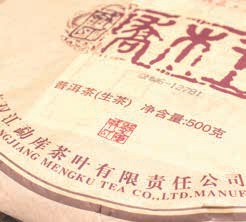
Wrappers are almost always made from natural fibers. These surround the cake itself. They help identify vintages and to some degree protect the cake. However, since the wrappers are made from natural fibers, there are more bugs that eat them than the tea. Many cakes' wrappers have nibble marks on them.
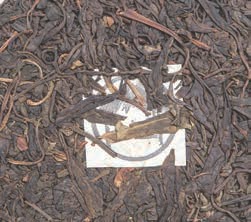
A nei fei is a small piece of paper mixed in with the tea and compressed into the cake. This is to verify brand and/or vintage even if the wrapper is lost. That can still be hard when it comes to vintage tea, as many nei fei are the same for years at a time.
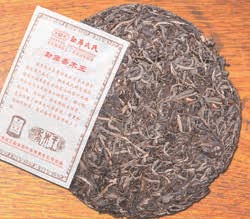
This is a paper that is sometimes inserted between the cake and the outer wrapping. Not all cakes have them. They often contain details about the production, region and sometimes even advertising. Some vintage nei piao even have broken English ads promoting the health benefits of puerh.
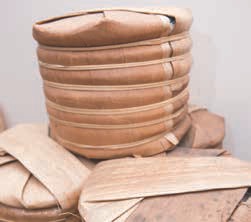
A tong is seven cakes wrapped up in bamboo bark. Sometimes bamboo twine is used to tie them, while other tongs are tied with metal. Traditionally, a tong was always seven cakes, but nowadays some are five.

Cases were traditionally twelve tongs bundled together, or eighty-four cakes. They were usually tied together with more bamboo twine for shipment. Nowadays cases can have more or less cakes, and are often cardboard boxes as opposed to the traditional bamboo jian.

Da piao were big brand labels that are attached to each jian. This sometimes is still practiced, but it was more prominent in previous eras. They often detail the batch, recipe, etc. We have one from the Antique Era in the center.